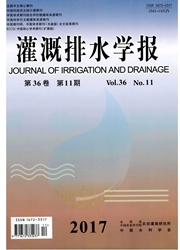

 中文摘要:
中文摘要:
以黄河流域内蒙古段及其周边地区44个气象站点、支流20个水文站点1956~2010年水文气象数据为基础,采用分区方式,选取典型支流水文站点,分析了径流对降水变化的响应。结果表明,径流对降水响应敏感。在1950S、1960S、1970S、1980S、1990S、2000s等6个阶段,随降水增减,径流呈现出相应变化趋势。多年来,降水呈微弱减少趋势,径流则呈现大幅度减少趋势。空间上降水多年平均减少量为0.21~14.92mm,径流减少量为65.38~818.38万m3。在2000S之前。降水不论增加还是减少。径流相应增减幅度平均为其1~8倍,个别在25~30倍之间;而在2000S,平均达到了11~17倍,个别达到69倍。较少的降水变化幅度会引起较大幅度的径流量变化。
 英文摘要:
英文摘要:
Regarding the Yellow River in Inner Mongolia as the study area, according to the climate and runoff sequence data in 44 meteorological stations and 29 hydrologic stations within and around the study area from 1956 to 2010, a typical hydrological site in the form of partition was selected to analyze the way of runoff change in response to precipitation change. The results showed that the runoff and precipitation had a close relationship, precipitation determined runoff. Response of precipitation to runoff was very sen- sitive and timely. In the 1950 s, 1960 s, 1970 s, 1980 s, 1990 s, 2000 s and so on six phase, along with changes in precipitation, runoff also reflected the corresponding change. For many years, precipitation showed a slight decreasing trend, and runoff showed a decreasing trend. Mean annual precipitation reduction was 0.21-14.92 mm, and annual mean runoff deduction was 65.38× 104 -818.38 × 104 m3 in the study area. Before the 2000 s, with the increase or decrease of precipitation, the corresponding runoff range average was as 1~8 times as precipitation change, and individual was 25~30 times; In the 2000 s, the average was 11~17 times, and individual was 69 times. Mean less precipitation change would cause a significant change of runoff.
 同期刊论文项目
同期刊论文项目
 同项目期刊论文
同项目期刊论文
 期刊信息
期刊信息
